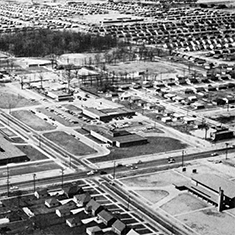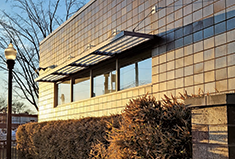Oak Park: A Brief History of Resilience
By Mayor Marian McClellan, City of Oak Park, Michigan
THE GEOGRAPHIC AREA NOW KNOWN AS THE CITY OF OAK PARK WAS ONCE described as “worthless, not fit for habitation.” Oak Park used to be one large marsh, complete with murky waters, abundant plant life, and Michigan swamp creatures.
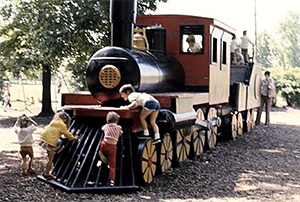 HOWEVER, DESPITE ITS EARLY, UNDESIRABLE FEATURES, THE AREA WAS INCORPORATED AS A VILLAGE in 1927, with fewer than 1,000 residents, and incorporated as a city 75 years ago in 1945.
HOWEVER, DESPITE ITS EARLY, UNDESIRABLE FEATURES, THE AREA WAS INCORPORATED AS A VILLAGE in 1927, with fewer than 1,000 residents, and incorporated as a city 75 years ago in 1945.
Prior to World War II, Oak Park was considered unfit for development. While Detroit suburbs flourished along the Woodward corridor and west of Greenfield, in 1945 Jewish land developers eyed Oak Park with interest as the war ended.
Some thought it would be a great place for an airport, while others considered building a racetrack (which eventually happened but in Hazel Park). Builders, however, felt it would attract Jewish residents to the suburbs where there were no land covenants restricting homeownership due to race and/or religion.
Before WWII, 20,000 pieces of lumber were required to build one new frame house, restricting contractors to 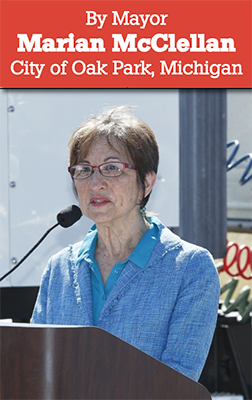 building only one or two homes per year. Prebuilt, ready-to-use modules made popular in the war, made it possible for one contractor to build 22 houses per year. Young families raced to occupy bright, new, modern homes in the suburbs.
building only one or two homes per year. Prebuilt, ready-to-use modules made popular in the war, made it possible for one contractor to build 22 houses per year. Young families raced to occupy bright, new, modern homes in the suburbs.
IN ADDITION TO PLENTIFUL HOUSING STOCK, THREE MAIN FACTORS drove Oak Park’s rapid and unique growth: 1) Accessible home financing through the military GI Bill for veterans; 2) Newfound housing opportunities for religious and racial minorities; and 3) Sound decisions by early city officials.
Some families moved to Oak Park to be nearer Northland Shopping Center, which was one of the first outdoor malls in the United States. However, the majority of Jewish families settled in the area due to Federal Housing Administration (FHA) and Veteran Administration (VA) rules for returning Jewish war veterans which required that they live in new construction outside of Detroit. This became the prevailing impetus for early Jewish settlement in both, Oak Park and Southfield.
Elected mayor in 1949, Gerald Kent had the foresight to hire a City planner to develop Oak Park’s first Master Plan, which, with recent modifications, still provides the basis for community development today. In 1951, Oak Park City Council combined policing, firefighting, and emergency medical services into one, innovative Public Safety Department, which became a national model.
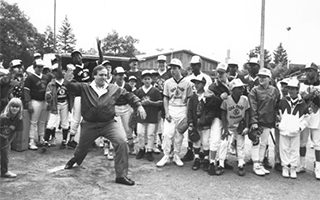 Oak Park Schools Superintendent James Pepper spearheaded new construction of eleven, state-of-the-art public schools within twelve years to match the City’s tremendous 565% population growth, of which 43 percent were school-aged children. By 1960 there were 10,000 children attending Oak Park schools annually.
Oak Park Schools Superintendent James Pepper spearheaded new construction of eleven, state-of-the-art public schools within twelve years to match the City’s tremendous 565% population growth, of which 43 percent were school-aged children. By 1960 there were 10,000 children attending Oak Park schools annually.
OAK PARK BECAME KNOWN AS THE FASTEST-GROWING CITY IN AMERICA, expanding from 2,000 to 37,300 residents between 1947 and 1963. Between 1950 and 1960, Oak Park became home to seven synagogues, five churches, a dozen baseball diamonds, a public swimming pool, a library, a recreation center, an ice rink and two parks. In 1960, the City introduced its first Independence Day Parade.
In the 1970s, white residents began moving away from Oak Park as black families moved into the City (a 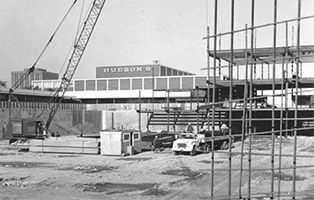 racist trend known as ). Oakland County encouraged urban sprawl, prompting families to move further out into the northwest suburbs. Many Jewish families stayed loyal to Oak Park, however, and welcomed the diversity. This transition period resulted in declining municipal revenues and, once again, destabilized Oak Park’s economy.
racist trend known as ). Oakland County encouraged urban sprawl, prompting families to move further out into the northwest suburbs. Many Jewish families stayed loyal to Oak Park, however, and welcomed the diversity. This transition period resulted in declining municipal revenues and, once again, destabilized Oak Park’s economy.
In the 1980s and 1990s, however, the City of Oak Park began bouncing back. The Jewish Federation started the Neighborhood Project in 1988, which provided Jewish families in Oak Park with interest-free loans for home-buying or improvements. Once again, Oak Park returned to being one of few stable, diverse communities in America.
AT THE ONSET OF THE CITY’S ECONOMIC RECOVERY, the State of Michigan and federal government proposed a project that threatened to destroy the community. The plan involved slicing the city in half to accommodate the construction of Interstate 696.
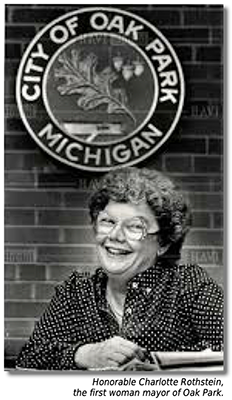 The Honorable Charlotte Rothstein, the first woman mayor of Oak Park elected in 1981, went to Washington, D.C. to lobby the federal government for assistance in building a pathway over the expressway so that families on either side could attend religious services. Mayor Rothstein’s dedication to literally building bridges helped stabilize Oak Park and maintain our diverse culture. Today, we celebrate the beautiful parks and crossways that run over the freeway and connect our community.
The Honorable Charlotte Rothstein, the first woman mayor of Oak Park elected in 1981, went to Washington, D.C. to lobby the federal government for assistance in building a pathway over the expressway so that families on either side could attend religious services. Mayor Rothstein’s dedication to literally building bridges helped stabilize Oak Park and maintain our diverse culture. Today, we celebrate the beautiful parks and crossways that run over the freeway and connect our community.
The Great Recession of 2007 had a devastating impact on Oak Park property values, as many residents lost their jobs and their homes. Caught in the back-draft of the worst economic crisis in 70 years, Oak Park had 100 vacant commercial and industrial properties. Property tax revenues fell by 50 percent, while Oak Park’s state revenue-sharing model plummeted by $5M as compared to the previous decade.
In November 2011, however, changes in Oak Park’s leadership initiated the City’s comeback. Once again, a series of sound government decisions rescued the City from potential bankruptcy and set Oak Park on a growth trajectory.
Today, Oak Park is progressing again relative to residential and business growth. In keeping with our history of resilience, Oak Park remains one of few stable, inclusive communities in the nation.

